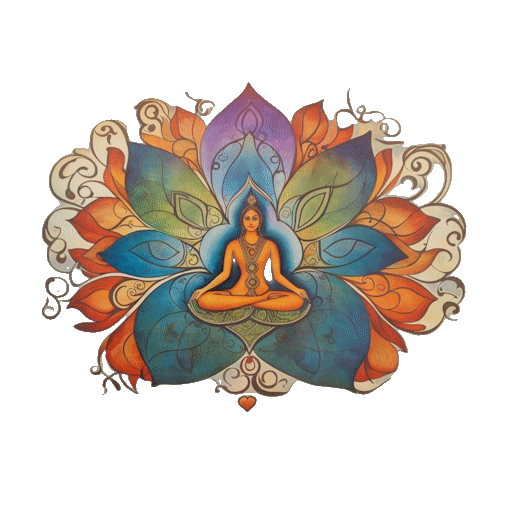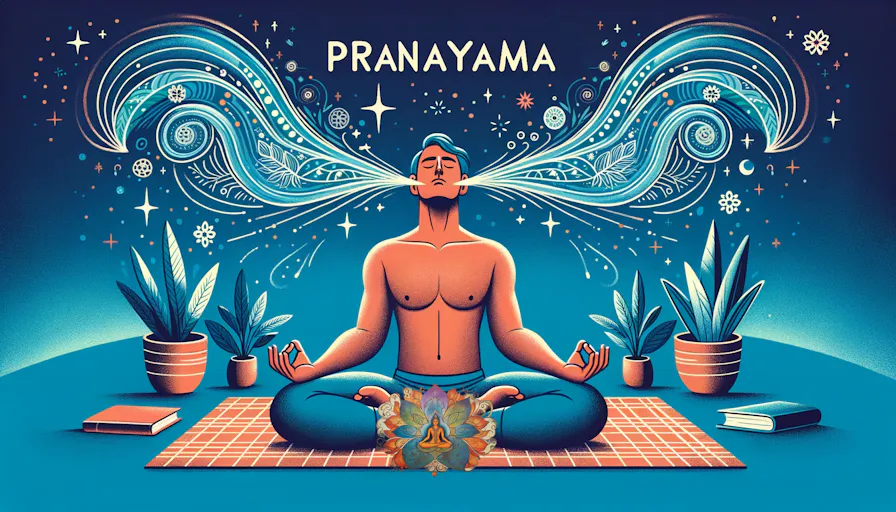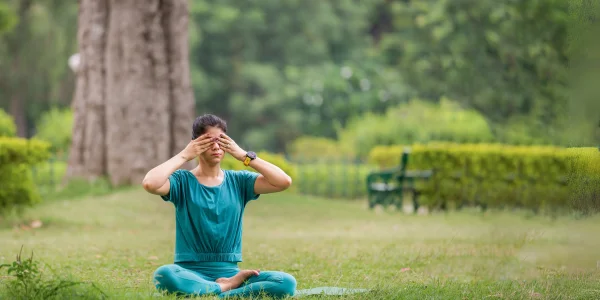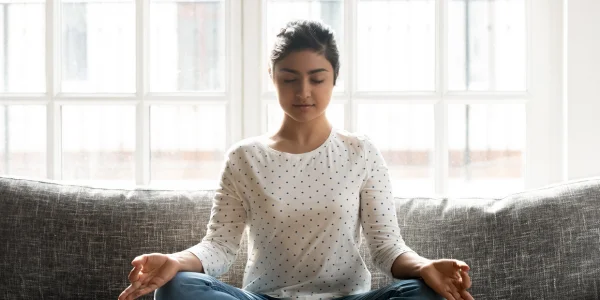Welcome to the serene and transformative world of Pranayama, the art of breathing, a cornerstone of yoga that harnesses the power of breath to enhance our physical, mental, and spiritual well-being.
Imagine walking through a lush forest, feeling the fresh air filling your lungs, and experiencing a sense of calm enveloping your mind. Pranayama offers a similar experience, where each breath we take becomes a step towards inner peace and balance. It’s more than just breathing; it’s a nurturing practice that allows us to cultivate a space where our minds can flourish and find tranquility.
Here you will discover the essence of Pranayama, unravel its various techniques, and explore its profound benefits. It’s like uncovering hidden gems that have the power to illuminate our path to wellness and mindfulness.
So, let’s delve into the practice of Pranayama, allowing its soothing rhythms to guide our hearts and minds toward a haven of tranquility and clarity. Together, we will explore how this ancient practice can become a cherished part of our daily lives, nurturing our journey toward holistic well-being.
Key Takeaways
- Understanding Pranayama
- Variety of Techniques
- Tailoring Practice to Individual Needs
- Medical Benefits in Western Medicine
- Guidance for Beginners
What is Pranayama?
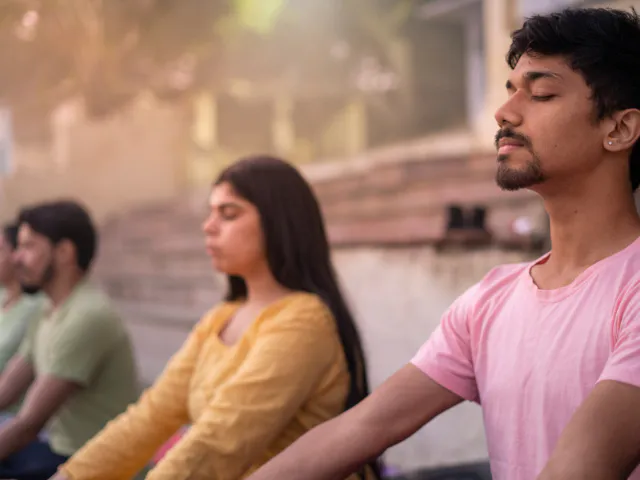
At its core, Pranayama is about breath control. It’s a series of exercises that teach us how to breathe more deeply, more effectively, and more consciously. It’s not just inhaling and exhaling; it’s about harnessing the power of breath to foster better health, vitality, and mindfulness.
Imagine your breath as a powerful tool. When used correctly, it can fill your body with energy, calm your mind, and help manage stress. Pranayama is like a guide, teaching us how to use this tool to enhance our physical and mental well-being.
In Pranayama, each yoga breathing technique has its own unique rhythm and flow. Some methods help energize the body, while others promote relaxation and calmness. It’s like having a toolbox, each tool with its own purpose and function, allowing us to navigate through life’s challenges with a sense of balance and ease.
So, as we step into the world of Pranayama, we are embracing a practice that has the potential to enrich our lives, nurture our well-being, and guide us toward a path of mindfulness and clarity.
Understanding the Meaning of Pranayama
Pranayama is a Sanskrit word that carries a deep and spiritual meaning. It’s like a beautiful tapestry woven with threads of ancient wisdom. Let’s gently unfold this term to grasp its essence.
“Pranayama” is composed of two roots: “Prana” and “Ayama.”
- Prana: This part signifies life force or vital energy. It’s the universal energy that flows through all living things, giving life and vibrancy. Imagine prana as the subtle energy that animates us, allowing our hearts to beat, our minds to think, and our spirits to soar.
- Ayama: This segment means control or extension. It represents the idea of regulating, mastering, and extending the breath and, consequently, the life force within us.
Unlocking the Benefits and Effects of Pranayama
Physical and Mental Well-being
Pranayama is like a fitness routine for our lungs and respiratory system. By engaging in these type of breathing exercises, we enhance our lung capacity and strengthen the respiratory muscles. It’s a practical way to promote our physical health, improving oxygen supply to the body, and boosting energy levels.
For a comprehensive approach to healing, consider exploring somatic therapy, which also focuses on the mind-body connection to address and heal trauma, reduce anxiety, and improve overall well-being.
On the mental front, Pranayama acts as a stress-reliever. It helps manage anxiety by calming the mind, improving focus, and promoting a sense of stability. It’s like having a mental reset button that helps clear away the mental clutter, allowing us to navigate our thoughts and emotions with greater ease.
Spiritual Upliftment
Pranayama also plays a role in enhancing our spiritual well-being. It fosters mindfulness, helping us stay present and attentive to the here and now. This practice encourages a deeper connection with our inner selves, cultivating a sense of inner peace and awareness.
Incorporating Pranayama into our daily routine is a way to nurture our overall well-being. It’s not just about the act of breathing; it’s about embracing a practice that enhances our capacity to live life with a sense of purpose, clarity, and calm. Through regular practice, we can unlock the full spectrum of benefits that Pranayama has to offer, enhancing our journey towards a balanced and harmonious life.
Exploring Forms of Pranayama Breathing Techniques
Anulom Vilom (Alternate Nostril Breathing)
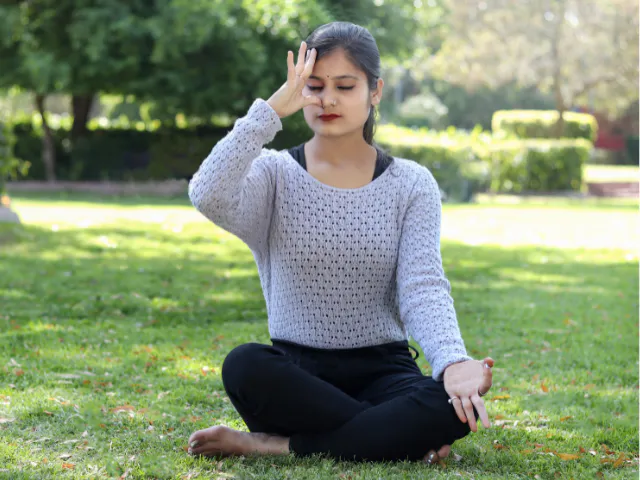
Anulom Vilom is like a dance of breath, flowing gracefully through alternate nostrils. It’s a practice that helps balance the two hemispheres of the brain, promoting mental equilibrium and reducing stress. Imagine creating a serene rhythm with your breath, one nostril at a time, harmonizing the mind and body.
How to Practice Anumlom Vilom:
- Sit in a comfortable position with a straight back and relaxed shoulders.
- Close your right nostril with your right thumb and inhale through the left nostril.
- Close the left nostril with your right ring finger, open the right nostril, and exhale.
- Inhale through the right nostril, close it, then open the left nostril and exhale. Repeat.
Kapalbhati Pranayama (Shining Skull Technique)

Kapalbhati is a vibrant method, like a burst of sunshine that energizes the mind and body. It involves a series of forceful exhalations followed by passive inhalations. Picture each breath out as a wave that washes away toxins and rejuvenates the body.
How to Practice Kapalbhati Pranayama:
- Sit comfortably, inhale deeply, and exhale forcefully through the nostrils, contracting the abdominal muscles.
- Allow the inhalation to happen passively, focusing on the forceful exhalations.
- Continue this process for a series of quick, forceful breaths.
Bhramari Pranayama (Bee Breath)
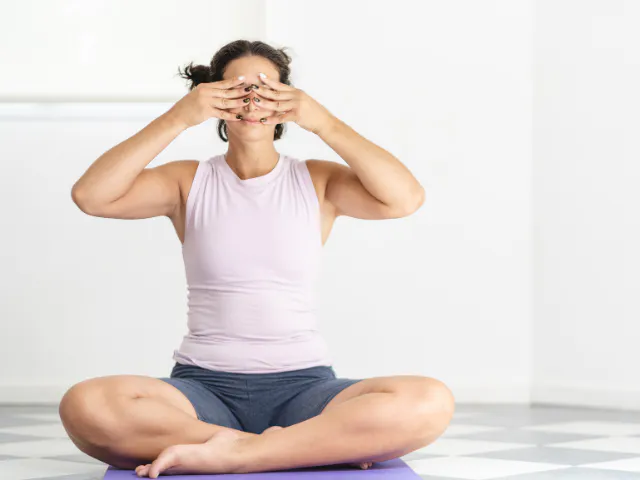
Bhramari Pranayama is like a soothing melody of a bee buzzing. It involves creating a soft humming sound during exhalation, which helps in calming the mind and reducing anxiety. Imagine the vibrations of the humming echoing through your being, bringing a sense of peace and calmness.
How To Practice Bhramari Pranayama:
- Sit quietly in a comfortable position. Close your eyes and take a few deep breaths.
- Close your ears with your thumbs and place your fingers on your forehead.
- Inhale deeply, and as you exhale, make a humming sound like a bee. Repeat.
Ujjayi Pranayama (Victorious Breath)

Ujjayi, often referred to as the victorious breath, is like a gentle tide that flows deep within. It’s practiced by constricting the back of the throat, creating a soft sound as you breathe. Envision the breath as a gentle wave, flowing smoothly, enhancing focus and warming the body.
How To Practice Ujjayi Breathing:
- Inhale deeply through the nose, slightly constricting the back of the throat.
- Exhale through the nose, maintaining the slight constriction in the throat, creating a soft sound.
- Focus on the sound and the flow of the breath.
Practice Pranayama for Different Needs

Pranayama for Stress and Anxiety
In the midst of life’s whirlwinds, Pranayama stands as a pillar of calm. Techniques such as Bhramari and Anulom Vilom act like gentle whispers that soothe the turbulent mind, helping alleviate stress and anxiety. They guide us towards a space of serenity where our minds can breathe freely and find rest.
Pranayama for Physical Vitality
Pranayama is not just a nourisher of the mind; it also infuses the body with vitality and vigor. Techniques like Kapalbhati invigorate the body, enhancing circulation and oxygenation. It’s like a refreshing breeze that revitalizes our physical being, promoting energy and wellness.
Pranayama for Beginners
For those new to this journey, fear not! Pranayama welcomes beginners with simplicity and grace. Starting with basic methods like deep diaphragmatic breathing can be a wonderful introduction. It’s about taking gentle steps, allowing the breath to be a guide, and gradually exploring deeper practices.
Pranayama for Enhanced Focus and Concentration
In the garden of Pranayama, the flowers of focus and concentration bloom beautifully. Techniques such as Ujjayi Pranayama help in enhancing mental clarity, improving our ability to concentrate and stay present. It’s like a gentle stream that clears the fog of distraction, allowing the mind to shine with clarity and purpose.
Embracing Technology in Pranayama Practice

In the modern world where technology intertwines with various aspects of our lives, embracing it in our Pranayama practice can be profoundly beneficial. Technology, in the form of apps and online platforms, brings the guidance and wisdom of Pranayama to our fingertips.
Various apps offer structured lessons, guided sessions, and customizable timers that cater to both beginners and seasoned practitioners. These tools can help in maintaining consistency, tracking progress, and exploring a diversity of Pranayama techniques with ease and flexibility. Some examples include Pause Breathwork & Oxyxen Advantage
By integrating technology into our practice, we open doors to a wealth of knowledge and guidance, allowing for a more enriched and supported Pranayama experience. So, as you delve into the realms of breath control and mindfulness, consider exploring the technological companions available to enhance your journey.
You Might Also Like:
Recognized Medical Benefits of Pranayama in Western Medicine
1. Stress and Anxiety Reduction
Pranayama practices like deep breathing and alternate nostril breathing have been found to help reduce stress and anxiety levels by modulating the response of the autonomic nervous system.1
2. Improved Respiratory Function
Regular practice of Pranayama has been associated with improved lung function and respiratory endurance, making it beneficial for conditions like asthma.2
3. Cardiovascular Health
Pranayama can enhance heart health by improving heart rate variability, reducing blood pressure, and promoting unwinding, which is beneficial for cardiovascular health.3
4. Enhanced Cognitive Function
Practices like alternate nostril breathing have been linked to improved cognitive function, enhancing focus and attention.4
5. Support in Smoking Cessation
Pranayama can be a supportive practice for individuals trying to quit smoking, as it helps in managing withdrawal symptoms and reducing stress.5
6. Improved Quality of Sleep
By promoting relaxation and reducing stress hormones, Pranayama can contribute to improving the quality of sleep and managing sleep disorders like insomnia.6
7. Management of Chronic Pain
The relaxation and mindfulness promoted by Pranayama can be beneficial in managing chronic pain conditions by altering the perception of pain.7
8. Support in Mental Health
Pranayama, as a part of yoga practice, has been found to be beneficial in managing mental health conditions like depression and anxiety disorders.8
While Pranayama is deeply rooted in ancient yogic traditions, its benefits have been recognized and studied in Western medicine. The practice is seen as a complementary approach that can support conventional medical treatments and enhance overall well-being. However, it’s essential to practice Pranayama under guidance and in consultation with healthcare professionals, especially when dealing with specific health conditions.
References
- Stress and Anxiety Reduction
Sahar G, et al. Breath of Life: The Respiratory Vagal Stimulation Model of Contemplative Activity. Frontiers in Human Neuroscience. 2018. ↩︎ - Improved Respiratory Function
Cramer H, et al. Yoga in women with abdominal obesity—a randomized controlled trial. Dtsch Arztebl Int. 2016. ↩︎ - Cardiovascular Health
Tyagi A, Cohen M. Yoga and heart rate variability: A comprehensive review of the literature. International Journal of Yoga. 2016. ↩︎ - Enhanced Cognitive Function
Pradhan B. Effect of kapalabhati on performance of six-letter cancellation and digit letter substitution task in adults. Int J Yoga. 2013. ↩︎ - Support in Smoking Cessation
Elibero A, Janse Van Rensburg K, Drobes DJ. Acute effects of aerobic exercise and Hatha yoga on craving to smoke. Nicotine Tob Res. 2011. ↩︎ - Improved Quality of Sleep
Hariprasad VR, et al. Yoga increases the volume of the hippocampus in elderly subjects. Indian J Psychiatry. 2013. ↩︎ - Management of Chronic Pain
Garfinkel MS, et al. Yoga-based intervention for carpal tunnel syndrome: A randomized trial. JAMA. 1998. ↩︎ - Support in Mental Health
Uebelacker LA, et al. Hatha yoga for depression: critical review of the evidence for efficacy, plausible mechanisms of action, and directions for future research. J Psychiatr Pract. 2010. ↩︎
FAQ
What is the best time to practice Pranayama?
Pranayama can be practiced at any time of the day that suits you, but it is often found to be most effective when done in the early morning or late evening. During these times, the environment is calm, and the mind is fresh, which can enhance the experience of the practice
Can Pranayama be practiced alone, or should it be combined with other yoga practices?
Pranayama can be practiced both as a standalone exercise or integrated into a broader yoga routine. When combined with asanas (yoga postures) and meditation, it can enhance the overall yoga experience by deepening the practice and increasing the flow of energy.
Are there any precautions to consider while practicing Pranayama?
Yes, it’s advisable to practice Pranayama on an empty stomach and in a calm, ventilated space. If you have any health conditions, it’s best to consult a healthcare professional or a certified yoga class instructor to tailor the practice to your needs.
How long should a beginner spend on Pranayama each day?
For beginners, starting with a few minutes each day is advisable. As you become more comfortable and familiar with the techniques, you can gradually increase the duration. Remember, consistency is key in Pranayama.
Can Pranayama help in managing mental health issues like anxiety and depression?
Pranayama can be a supportive tool in managing mental health by promoting relaxation, reducing stress, and improving focus. However, it should not be considered a replacement for professional mental health treatment and advice.
What are the 4 basic pranayamas?
There are several pranayama techniques, each with its unique benefits and methods. Five basic pranayamas that are commonly practiced include:
Anulom Vilom (Alternate Nostril Breathing)
Kapalbhati Pranayama (Shining Skull Technique)
Bhramari Pranayama (Bee Breath)
Ujjayi Pranayama (Victorious Breath)
What is the most powerful pranayama?
It’s challenging to pinpoint a single pranayama as the “most powerful” because the effectiveness of a pranayama can vary based on individual needs and experiences. However, many practitioners find Kapalbhati and Bhastrika Pranayama to be quite powerful due to their energizing and purifying qualities.
Which pranayama is best for beginners?
For beginners, it might be beneficial to start with simpler pranayama techniques like Deep Breathing (Sama Vritti Pranayama) and Anulom Vilom (Alternate Nostril Breathing). These practices are gentle yet effective, paving the way for a deeper exploration of pranayama.
Where do I start with pranayama?
Starting with pranayama can begin with understanding your breath, followed by practicing basic breathing exercises. You might also consider learning from a knowledgeable instructor or using reliable resources to guide your initial steps into pranayama practice.
What does pranayama do to your body?
Pranayama nurtures the body by improving respiratory efficiency, enhancing oxygen supply to various body parts, balancing the nervous system, and aiding in stress management and relaxation.
Does pranayama increase oxygen levels?
Yes, pranayama can enhance the oxygen levels in the body. By promoting deeper and more efficient breathing, pranayama helps in improving oxygen intake and circulation in the body.
